DCPA NEWS CENTER
Enjoy the best stories and perspectives from the theatre world today.
Enjoy the best stories and perspectives from the theatre world today.
 Developed by DCPA Education and Community Engagement | education@dcpa.org | 303.446.4892
Developed by DCPA Education and Community Engagement | education@dcpa.org | 303.446.4892
In the Great Green Room is a resource of five lesson plans that provide you and your classroom or family with five pre-show sessions in anticipation of attending the Denver Center for the Performing Arts’ production of Goodnight Moon. Each session is designed with step-by-step facilitation that activates ideas and themes based upon the beloved picture book of ‘good nights’ by Margaret Wise Brown (words) and Clement Hurd (pictures).
The sessions invite you and your students to return to the book after you have done an initial reading of Goodnight Moon, to expand ideas and themes suggested within the book’s text and images. Session 4 is specific to The Runaway Bunny, also by Brown and Hurd, which is also used in the production.
Note that most versions of the book do not have page numbers so each session will indicate what text to begin and end on.
Each session follows the following sequence of activities – with content changing within each session:
Each activity can be modified to fit any content, so once you play these activities for Goodnight Moon, feel free to modify them to activate other curriculum, circle-time content, or favorite book titles.
Goodnight Moon by Margaret Wise Brown. Pictures by Clement Hurd
Harper Trophy – Harper Collins Publisher | ISBN: 9789990926378
Did you notice how the pictures in the book change?
The book is also very specific about time. Look at the pictures of the clock: 7:00, 7:40, 8:00, the change in the great green room’s lighting, and Little Bunny going from being wide awake to being sleepy.
Look at the picture of the three little bears sitting in chairs (p. 4) and the little house (p. 19). Many readers of the book think the room the bears are sitting in is within the little house as there are similar curtains in both. The bears’ room also has the same ‘cow jumping over the moon’ picture as the one in the great green room.
In the production, look for all of the objects in the book within the stage set. How does the production bring the great green room to life? Does the production add any new characters to the great green room?
Goodnight Moon by Margaret Wise Brown. Pictures by Clement Hurd
Harper Trophy – Harper Collins Publisher | ISBN: 9789990926378
• BEGIN: In the great green room . . . (p. 1)
• END: And a little toyhouse. And a young mouse. (p. 6)
The book begins with a sense of suspense! See the dash [ – ] at the end of the first page? The dash invites us to wait for the page to turn before we learn what else is in the great green room.
The book uses two types of rhymes. End rhymes (such as kittens and mittens – the final words in a line of text sound the same [they rhyme]) and slant rhymes (such as room, moon, and balloon – the words in a line of text share the same vowel sound).
PREK AND KINDERGARTEN
Examples of words to call in order: bat, hop, cat | spring, log, king | quake, bite, snake | sheep, car, creep [or have the class create their own list for you to call from].
1ST AND 2ND GRADE
Examples of poems to read (Riddles-For-Kids.org):
She’s the head of a hive
On a chessboard she is seen
She’s in a deck of cards
Which means that she is a: [queen]
If you’ve lots of letters to mail
Then this product can help you cope\
Addresses and stamps go on the front
Which means it is an: [envelope]
During the production, listen for rhymes in the production’s songs. You might also recognize a nursery rhyme involving a cat, a fiddle, a cow, the moon, a laughing dog, and a dish and spoon.
Goodnight Moon by Margaret Wise Brown. Pictures by Clement Hurd
Harper Trophy – Harper Collins Publisher | ISBN: 9789990926378
• BEGIN: Goodnight nobody (p. 23)
• END: Goodnight nobody (p. 23)
The American poet, Emily Dickinson, wrote this poem published in 1891:
I’m Nobody! Who are you?
Are you Nobody too?
Then there’s a pair of us!
Don’t tell! They’d banish us, you know!
How dreary to be Somebody!
How public like a Frog,
To tell one’s name the livelong June
To an admiring Bog!
During the production, listen for a song about Nobody and look to see how Nobody becomes a somebody in the
production.
The Runaway Bunny by Margaret Wise Brown. Pictures by Clement Hurd
Harper Trophy – Harper Collins Publisher | ISBN: 9780007494842
The activity can be modified as a circle activity with students responding to the object/detail to the player on their right.
During the production, listen for a song inspired by the book, The Runaway Bunny. This song will tell you who the characters in the illustration are in relation to the character of Little Bunny.
Goodnight Moon by Margaret Wise Brown. Pictures by Clement Hurd
Harper Trophy – Harper Collins Publisher | ISBN: 9789990926378
During the production, listen for a final song inspired by all the words in the book. In what way(s) is what you see on stage at the end of the production the same as the book’s final illustration? How is it different?
